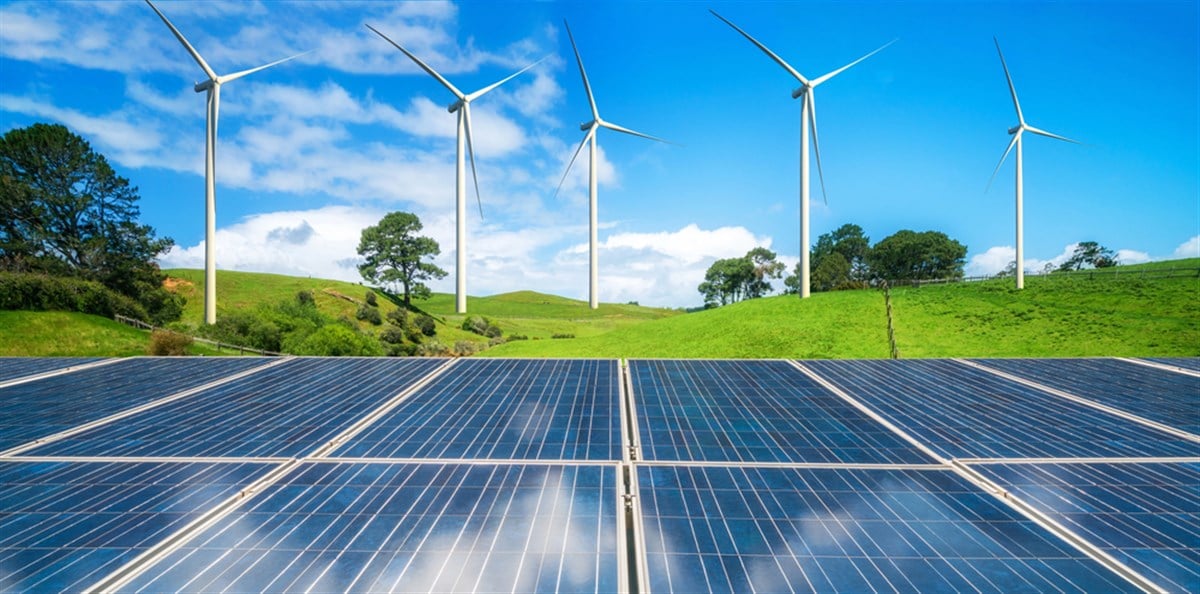 As Trump moves to block new permits for wind and solar projects, renewables—which were enjoying a strong year—will likely pull back. But... ͏ ͏ ͏ ͏ ͏ ͏ ͏ ͏ ͏ ͏ ͏ ͏ ͏ ͏ ͏ ͏ ͏ ͏ ͏ ͏ ͏ ͏ ͏ ͏ ͏ ͏ ͏ ͏ ͏ ͏ ͏ ͏ ͏ ͏ ͏ ͏ ͏ ͏ ͏ ͏ ͏ ͏ ͏ ͏ ͏ ͏ ͏ ͏ ͏ ͏ ͏ ͏ ͏ ͏ ͏ ͏ ͏ ͏ ͏ ͏ ͏ ͏ ͏ ͏ ͏ ͏ ͏ ͏ ͏ ͏ ͏ ͏ ͏ ͏ ͏ ͏ ͏ ͏ ͏ ͏ ͏ ͏ ͏ ͏ ͏ ͏ ͏ ͏ ͏ ͏ ͏ ͏ ͏ ͏ ͏ ͏ ͏ ͏ ͏ ͏ |
| | Written by Jordan Chussler 
President Trump’s distaste for wind turbines near his golf course in Scotland is well-documented. Now he’s taking that fight stateside. Last week, he announced via Truth Social an effort to prevent any new wind or solar projects from being approved in the United States. That may have been welcome news for Big Oil, but it wasn’t for the renewable energy industry, which, despite policy headwinds, was enjoying a strong year in the lead-up to Trump’s social media declaration on Aug. 20. Through Aug. 19, the Invesco Solar ETF (NYSEARCA: TAN) had gained 18%, the iShares Global Clean Energy ETF (NASDAQ: ICLN) had increased by 23%, and the First Trust Global Wind Energy ETF (NASDAQ: WNDY) had gained 27%. Meanwhile, the S&P 500 was up 9.25%, and the fossil fuel industry’s flagship fund—the Energy Select Sector SPDR Fund (NYSEARCA: XLE)—had posted a year-to-date (YTD) loss of 1.82%. On the surface, circumstances may have changed. But before panic-selling, investors with positions in green energy should understand the undercurrents of the U.S. electric power production landscape and the global supply-demand picture. Electricity Is Skyrocketing, But Not Because of Renewables The president’s disdain for renewable energy is misattributed. His Aug. 20 Truth Social post put forth the claim that wind and solar were responsible for “RECORD BREAKING INCREASES IN ELECTRICITY AND ENERGY COSTS.” According to data, that isn’t the case. In June, global financial services firm Lazard released its annual Levelized Cost of Energy (LCOE) report, which found that unsubsidized utility-scale solar prices range from 3 cents to 7 cents per kilowatt-hour (kWh) and onshore wind prices range from 3 cents to 8 cents per kWh. By contrast, newly constructed natural gas plants cost 13 cents to 26 cents per kWh before factoring for input price volatility. The LCOE report also found that 91% of global utility-scale renewable projects are more cost-effective than fossil fuel counterparts. Specifically, solar is 41% cheaper and onshore wind is 53% cheaper than even the lowest-cost fossil fuel options. Energy analysts attribute skyrocketing electricity costs in the United States to increased demand (specifically from energy-intensive cloud computing and AI data center needs), aging infrastructure, and increasingly extreme weather due to climate change. Making matters worse, CNBC reported on Monday that Trump’s attack on renewables will further exacerbate the issue, leading to a supply crunch and spiking electricity prices. Short-Term U.S. Policy Won’t Disrupt a Global Trend The United States is often—and erroneously—conflated with the stock market as a whole. While its policies and economy have outsized impacts on publicly traded companies, they aren’t synonymous. Nonetheless, the global economy and its impact on stocks is often disregarded by investors whose isolated views focus singularly on how U.S. policies impact performance. While Trump may be hindering the development of clean energy sources in the United States, those actions have little impact on the industry worldwide. According to Goldman Sachs, renewables are thriving despite the president’s efforts to stifle them domestically. Research published by the investment bank this month indicates that the outlook for the global solar energy industry remains bright, citing that the “solar electricity generation surge [has been] the fastest in the history of electricity.” In the 12 months leading up to July 2025, solar accounted for 8% of all global electricity output, with Goldman Sachs noting that “while the U.S. and China have reduced support for the sector, solar energy is still likely to meet a high share of global energy demand in the long run.” The report added that solar energy’s marginal fuel costs are zero, meaning that there are no associated costs with every additional unit of electricity produced after accounting for the original cost of photovoltaic installation and maintenance. Global supply chain bottlenecks are unlikely, with Goldman Sachs finding that China’s production potential in 2024 represented an excess capacity to the tune of 200% of global demand. From 2025 to 2030, Grand View Research forecasts a 10.6% CAGR for the global solar market and a 4.9% CAGR for the global wind power market. Renewable Energy ETFs With Global Footprints The operative word in this narrative is “global.” The aforementioned ETFs hold foreign securities that expose shareholders to growth-focused renewables unhindered by the current U.S. administration’s anti-renewable stance. TAN, for example, includes companies operating in Hong Kong and Israel. ICLN has positions in Portuguese and Japanese utilities, and WNDY holds companies headquartered in Denmark and China. Those three funds have expense ratios of 0.38%, 0.41%, and 0.51%, respectively, meaning that for buy-and-hold investors, their positions won’t be eroded by fees even if there is short-term fallout from the White House.  Read This Story Online Read This Story Online |  |
| Written by Jeffrey Neal Johnson 
Shares of MINISO Group (NYSE: MNSO) surged over 20% in the trading session following its second quarter 2025 earnings report, a dramatic move that signaled more than just a positive quarter. The market’s enthusiastic response delivered a clear verdict on the company's evolving business strategy. The company’s recent performance is the result of a powerful two-part strategic formula: an aggressive international expansion centered on larger store formats and a highly profitable product model built on popular intellectual property. Together, these pillars are successfully transforming MINISO from a China-centric value retailer into a dynamic global growth story within the retail sector, fundamentally reshaping MINISO’s investment case for the future. What MINISO's Latest Report Reveals The market's reaction was grounded in a set of financial results that provided a clear picture of accelerating momentum for the quarter that ended June 30, 2025. The data reveals a significant strategic shift, with international operations clearly taking the lead as the company's primary growth engine. - Robust Top-Line Growth: Total revenue climbed 23.1% year-over-year to approximately $695 million (RMB 4.97 billion), surpassing the high end of the company's own guidance and signaling strong operational execution.
- The International Growth Engine: The report highlighted a crucial divergence in regional performance. While revenue from the MINISO brand in mainland China grew a respectable 13.6%, revenue from overseas markets jumped by an impressive 28.6%.
- The TOP TOY Catalyst: The company's pop culture and toy division, TOP TOY, continued its explosive trajectory, with revenue growing a record 87.0% year-over-year, positioning it as a critical growth accelerator.
- Core Retail Health: Group-level Same-Store Sales Growth (SSSG) turned positive for the first time in a year, a vital metric indicating that existing stores are generating more revenue and that the brand's appeal is strengthening.
- Impressive Profitability: The group-level gross margin remained strong at 44.3%. This translated to the bottom line, with adjusted net profit increasing 10.6% to about $96.7 million (RMB 691.5 million) and adjusted diluted earnings per American Depository Share (ADS) rising 12.0%.
MINISO's Superstore Blueprint Goes Global These strong international results directly result from a deliberate shift in the company's global retail strategy. MINISO is moving beyond its traditional small-format stores to invest in larger superstores and flagships in prime international locations, including a high-profile Times Square store. This approach focuses on creating an enhanced, immersive customer experience to build a powerful brand presence in key Western markets. This marks a strategic evolution from the company's historically asset-light partner model, and the strong financial returns validate the higher investment. The data confirms this strategic focus. The company's overseas network has reached 3,307 MINISO stores, with nearly 75% of its net new locations opening outside of mainland China in the past year. MINISO gains greater control over its brand image and merchandising by investing in these larger, often directly-operated stores. According to company management, this strategy successfully unleashes higher sales potential and optimizes profit margins, building a foundation for sustainable long-term expansion. How Sanrio and Disney Fuel MINISO's Profits Complementing its expanding physical footprint is a sophisticated product strategy that directly fuels its high profitability. The company has masterfully executed what it calls interest-based consumption, which involves tapping into consumer passions and fandoms by collaborating with globally recognized intellectual property (IP) holders. Popular collections featuring characters from Sanrio, Disney, Peanuts, and Barbie have become major draws for the brand. This IP-centric model is a primary driver behind the substantial 44.3% gross margin. These co-branded products command higher price points and create a unique treasure hunt experience that encourages repeat visits. This strategy’s success was further validated when the TOP TOY brand recently completed a strategic financing round led by global investment firm Temasek, valuing the division at approximately $1.28 billion (HKD $10 billion). This investment provides both capital and a powerful endorsement of MINISO’s IP-driven approach, elevating it far above traditional value retailers and fostering a loyal global customer base. Why Wall Street Is Turning Bullish On MNSO The strength of this two-pronged strategy has not gone unnoticed by the financial community. Following the earnings release, Jefferies upgraded the stock to a Buy rating, and Bank of America raised its rating to Neutral. This signals that analysts are recognizing the sustainability of this new growth model. Adding to this confidence, management provided an optimistic full-year outlook, projecting revenue growth of at least 25%. The key takeaway for investors is the powerful collaboration at play. The new superstores provide the perfect stage, and the high-margin IP products are the star performers. This combination creates a scalable and profitable formula for global expansion that has been proven effective. The recent stock surge is not a temporary reaction to a single good quarter. It represents the market pricing in a new reality: MINISO has a clear international playbook, is executing that plan effectively, and is solidifying its position as a compelling global growth stock.  Read This Story Online Read This Story Online |  |
| Written by Nathan Reiff 
Though many of the biggest names in the investing world have already reported earnings in this most recent cycle, some lesser-known firms remain yet to report. Besides being a key way for investors to monitor companies' progress in achieving their strategic goals, these reports are often a catalyst for share price shifts. Anticipating a strong earnings report can allow investors a chance to capitalize on a share spike, for those willing to take the risk. Of course, it's always difficult to tell how a company will perform when it comes time for earnings, just as it can be equally hard to say how the market will react. However, three companies reporting earnings in the final week of August 2025 have strong support from analysts across Wall Street, and this may be enough to draw the attention of some investors looking to play the earnings cycle. Can Accelerating Earnings Reverse Course For This Medical Products Firm? The Cooper Companies Inc. (NASDAQ: COO) is a medical device firm comprising CooperVision and CooperSurgical, with focuses on contact lenses and women's health products, among other things. While the company's revenue climbed by 6% year-over-year (YOY) on equally strong demand for both contact lenses and surgical products in the second quarter, reported in May, shares of COO have still declined by a significant 19% or so year-to-date (YTD). This week's earnings report could drive a shift in trajectory for the stock, but it will depend on Cooper showing that it can stand up to the headwinds imposed by tariffs, inflation, and other factors. Investors might want to see the company keep improving its gross margin, which reached 68% in the latest report, or to recognize the continued strong performance in Cooper's premium areas, such as myopia management. Expectations are high for the company's daily silicone hydrogel portfolio, which climbed by double digits in the last earnings filing. Although the company's fertility segment was a disappointment in the last report, with growth of just 2% year-over-year due to clinic capital delays, a faster pace here could also help turn things around. Analysts seem to think Cooper will be able to meet some of these expectations. Ten out of 12 have rated COO a Buy, and a consensus price target of $96.73 is more than 31% higher than the share price heading into earnings week. Agilent's Transformation Has Been Successful, But Earnings Can Help Confirm A maker of systems and components used by clients in the life sciences, diagnostics, and applied chemical spaces, Agilent Technologies Inc. (NYSE: A) has recently undergone a reorganization process that has already yielded success. Agilent has reorganized into three groups: Life Sciences and Diagnostics Markets, Applied Markets, and Agilent CrossLab. This move, known as Ignite, aims to drive up to 7% annual growth in core revenue and increase operating margin by 50 to 100 basis points per year, among other benefits. Besides making Agilent more, well, agile, the Ignite transformation has helped to shore up the company's supply chain in the face of trade uncertainty, and to boost its geographical diversification. What investors might be looking for in earnings this week is confirmation that the process will in fact yield the benefits to revenue, EPS, and margin that the company has touted. Investors are split on A shares, with six seeing them as a Buy and six as a Hold. With the stock declining almost 11% YTD, the consensus price target suggests about 17% in upside potential. Improving Financial Performance and Adoption May Be Enough to Supercharge Growth for Autodesk Autodesk Inc. (NASDAQ: ADSK) provides software and platforms allowing designers and engineers to integrate vital data into preconstruction and design projects. With strong adoption of its tools driving steady revenue growth, the company reported a notable 15% year-over-year revenue increase in its latest earnings report before late August. Operating profit also saw a slighter margin of growth. The company's free cash flow is also improving, generating a solid $549 million in the latest quarter. This is crucial for a tech firm that invests heavily in developing new technologies and products, so investors will likely want to see that number grow if possible. Unlike the two companies above, ADSK shares have not plunged by double digits YTD. Rather, they have fallen by under 3% so far this year. Even so, with analysts reaching a consensus price target over 20% above the current price, and 17 out of 24 rating the stock as a Buy, expectations are pretty high heading into earnings week.  Read This Story Online Read This Story Online |  While many are busy chasing the usual AI trends, a bigger opportunity is quietly brewing—and most are missing it. Imagine a major shift in how and where AI is built, opening up incredible wealth opportunities for those in the know.
I've found 9 AI companies primed to lead this change. These aren't the tired "AI hype" stocks; they're companies with real US operations, proven revenue growth, and deep AI integration. I've put all the details in a FREE report: "Top 9 AI Stocks For This Month." |
| More Stories |
| |
|
|
0 Response to "🦉 The Night Owl Newsletter for August 26th"
Post a Comment